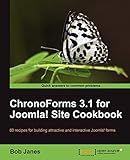Best Tools for Joomla Installation to Buy in December 2025

Joomla! A User's Guide: Building a Successful Joomla! Powered Website



Joomla! Explained: Your StepbyStep Guide (Joomla! Press)



ChronoForms 3.1 for Joomla! Site Cookbook



Blogging with Joomla: Everything you ever wanted to know about building a blog with Joomla



Joomla! 4 - Guida completa (Italian Edition)


To install Joomla on XAMPP, you need to follow these steps:
- Download Joomla: Visit the Joomla website and download the latest version of Joomla.
- Install XAMPP: Download and install XAMPP onto your computer.
- Start XAMPP: Open the XAMPP Control Panel and start the Apache and MySQL modules by clicking on the "Start" button next to each one.
- Create a database: Open your web browser and go to "localhost/phpmyadmin". Click on "Databases" in the top menu and create a new database for your Joomla installation.
- Extract Joomla files: Extract the downloaded Joomla files into the "htdocs" folder of your XAMPP installation. Rename the extracted Joomla folder if desired.
- Configure Joomla: Open your web browser and go to "localhost/your-joomla-folder". Follow the on-screen instructions to configure Joomla. Provide the database details you created in Step 4.
- Complete installation: Once the configuration is complete, click on the "Install" button. Joomla will install and create all the necessary tables in the database.
- Remove the installation folder: After the installation is complete, you will be prompted to remove the installation folder. Delete the "installation" directory from your Joomla folder.
That's it! Joomla is now installed on XAMPP, and you can start building your website using Joomla's powerful content management system.
How to configure MySQL in XAMPP?
To configure MySQL in XAMPP, follow these steps:
- Start XAMPP control panel and make sure the Apache and MySQL services are running.
- Open your web browser and type "localhost/phpmyadmin" in the address bar.
- In the phpMyAdmin interface, click on the "User Accounts" tab.
- From the User Accounts page, click on the "New" button to create a new MySQL user.
- Enter a username and password for the new user. You can also specify the host from which the user can connect.
- After entering the user details, click on the "Go" or "Apply" button to save the changes.
- Next, you need to configure the MySQL database settings in XAMPP. Open the "config" folder located in the root directory of XAMPP installation.
- In the "config" folder, find the "my.ini" or "my.cnf" file and open it with a text editor.
- Look for the [mysqld] section in the configuration file. In this section, you can set various MySQL server settings such as port number, socket, character set, etc.
- Save the changes made to the configuration file and restart the MySQL server in XAMPP.
- To test the MySQL configuration, create a new PHP file in the htdocs folder of XAMPP. Use the following code to connect to the MySQL database:
Replace "your_username" and "your_password" with the username and password you created in the phpMyAdmin interface.
- Save the PHP file and open it in your web browser. If the connection is successful, it will display the message "Connected to MySQL successfully."
By following these steps, you can successfully configure MySQL in XAMPP for your local development environment.
What is a control panel in XAMPP?
In XAMPP, the control panel is a graphical user interface (GUI) application that allows users to manage the various components and settings of XAMPP. It provides an easy way to start, stop, and configure the Apache web server, MySQL database server, FileZilla FTP server, and other related services included in XAMPP. The control panel also displays the status and logs of each component, making it convenient for users to monitor and troubleshoot any issues that may arise during development or testing.
How to set up the FTP configuration in Joomla?
To set up the FTP configuration in Joomla, follow these steps:
- Log in to your Joomla administration panel.
- Go to the System menu and click on Global Configuration.
- In the Global Configuration page, click on the Server tab.
- Under the FTP Settings section, you will find three options: FTP Layer, FTP Settings, and FTP enable. FTP Layer: Set it to "No" if you want to disable the FTP layer. FTP Settings: Enter your FTP host, FTP username, and FTP password. FTP Enable: Set it to "Yes" if you want to enable FTP.
- Save the changes by clicking on the Save button at the top left of the page.
Note: The FTP Layer and FTP Settings options are usually used when you encounter file permission issues during the installation or updates of Joomla extensions.
By configuring the FTP settings in Joomla, you will be able to install extensions, update Joomla, or make changes to files using FTP when necessary.
How to download XAMPP?
To download XAMPP, follow these steps:
- Open your web browser and go to the official XAMPP website at https://www.apachefriends.org/.
- On the main page, you will see different versions of XAMPP available for download. Choose the version that is compatible with your operating system (e.g., Windows, macOS, Linux).
- Click on the "Download" button for the selected version.
- You will be redirected to a download page. Here, you can choose to download the installer package or the ZIP archive. The installer package is recommended for most users as it provides an easy installation process.
- Click on the "Installer" to download the installer package. The download process will start automatically. Alternatively, if you choose the ZIP archive, click on the "ZIP" link to download the archive.
- Once the download is complete, locate the downloaded file on your computer. If you downloaded the installer package, it will usually be in your "Downloads" folder. If you downloaded the ZIP archive, extract the contents to a desired location.
- Run the XAMPP installer or navigate to the extracted files if you downloaded the ZIP archive.
- Follow the installation instructions provided by the installer. Select the components you wish to install (e.g., Apache, MySQL, PHP), and specify the installation directory if prompted.
- Once the installation is complete, you will have XAMPP installed on your computer. You can now start configuring and using XAMPP for web development or local server purposes.
Note: During the installation process, you may encounter prompts from your operating system or antivirus software. Make sure to allow the installation to proceed by granting necessary permissions.
What is the purpose of selecting a language during installation?
The purpose of selecting a language during installation is to set the primary language for the user interface (UI) and the system's default language. This ensures that all text, menus, prompts, and messages are displayed in the chosen language, making it easier for the user to understand and navigate through the software or operating system.
By selecting the desired language during installation, the user can customize their experience and have a more comfortable and familiar environment for using the software or operating system. It eliminates the need for language translation or localization settings to be changed later, simplifying the initial setup process.
Moreover, the language selection also affects the keyboard layout and input methods available, making it easier for the user to type or input text using their preferred language's conventions. This ensures a seamless experience and enhances usability for individuals who may not be fluent in other languages.
How to set up the database connection for Joomla in XAMPP?
To set up a database connection for Joomla in XAMPP, follow these steps:
- Start XAMPP and make sure Apache and MySQL modules are running.
- Open a web browser and type "localhost" in the address bar. This will open the XAMPP start page.
- Click on the "phpMyAdmin" link in the navigation menu to open the database management interface.
- In phpMyAdmin, click on the "Databases" tab and create a new database for your Joomla site. Choose a name and click "Create".
- Download the Joomla installation package from the official Joomla website (https://www.joomla.org/download.html). Extract the files to the "htdocs" folder in your XAMPP installation directory.
- Open a web browser and type "localhost/your-joomla-folder-name" in the address bar. This will start the Joomla installation process.
- In the Joomla installation page, select your preferred language and click on the "Next" button.
- On the Pre-Installation Check page, make sure all the required settings are green and click "Next".
- On the Database Configuration page, enter the following information: Database Type: Select "MySQL" from the dropdown menu. Host Name: Enter "localhost". Username: Enter the MySQL username for your XAMPP installation (usually "root"). Password: Enter the MySQL password for your XAMPP installation (usually empty). Database Name: Enter the name of the database you created in phpMyAdmin in step #4. Table Prefix: Optionally enter a table prefix to avoid conflicts with other installations.
- Click on the "Next" button to proceed with the installation.
- Follow the remaining steps in the Joomla installation process, including the Site Configuration where you will enter your site name, email, and other details.
Once the installation is complete, you should have a functioning Joomla site running on XAMPP with a database connection set up.
How to configure Joomla installation through the web browser?
To configure Joomla installation through the web browser, you can follow these steps:
- Download the latest version of Joomla from the official website (https://www.joomla.org/download.html) and extract the installation files to a local folder on your computer.
- Upload the extracted files to your web server using an FTP client or file manager provided by your hosting provider. Make sure to upload them to the root directory or a subdirectory where you want to install Joomla.
- Open your web browser and enter the URL of your Joomla installation folder. For example, if you uploaded the files to the root directory, you would enter http://example.com in the browser's address bar.
- The Joomla installation process will begin, and you will be presented with the Joomla CMS installation page. Select your preferred language and click the "Next" button.
- Check the pre-installation checks to ensure your server meets the minimum requirements for Joomla. If any issues are identified, you may need to contact your hosting provider to resolve them.
- Enter the details for your MySQL database. This includes the database type, host name, database name, username, and password. If you don't have this information, you will need to create a new MySQL database through your hosting control panel.
- Customize the FTP configuration if required. This is helpful for automatic installation of Joomla extensions.
- Enter the site name, description, administrator email, username, password, and language details for your Joomla website. Choose a strong password for the administrator account to ensure the security of your site.
- Review the configuration settings and ensure they are correct. If everything looks good, click the "Install" button.
- The Joomla installation process will begin, and you will see a progress bar indicating the status. Once the installation is completed, a success message will be displayed.
- Remove the installation folder from your server. This is crucial for security purposes, and you can do this by deleting the "installation" folder using your FTP client or file manager.
- Access your Joomla website front-end and back-end using the provided URLs and login credentials. You can start customizing and building your Joomla website from there.
Remember to always keep your Joomla installation, themes, and plugins updated to ensure the security and stability of your website.
What are the essential files in a Joomla installation?
The essential files in a Joomla installation are:
- index.php - This is the main entry point for the Joomla site and handles the routing and initialization of the system.
- configuration.php - This file contains the configuration settings for the Joomla installation, including database connection details and site-specific settings.
- libraries/ - This directory contains the core libraries and classes that power Joomla, including the framework, database, and user management.
- administrator/ - This directory contains the files and folders for the Joomla administrator area, where site management and configuration tasks are performed.
- components/ - This directory contains the core components of Joomla, such as articles, menus, and users. Additional third-party components can also be installed in this directory.
- templates/ - This directory contains the template files that define the look and feel of the Joomla site.
- plugins/ - This directory contains the plugins that extend the functionality of Joomla, such as content editors, authentication methods, and search engines.
- modules/ - This directory contains the modules, which are smaller functional units that can be placed within the template layout, such as menus, login forms, or banners.
- media/ - This directory contains the media files, such as images, videos, and documents, used in the Joomla site.
- language/ - This directory contains the language files for translating the Joomla interface into different languages.
These are the core files and directories that are crucial for a Joomla installation to function properly. Additional files may be added by extensions, templates, or custom development to meet specific needs.
How to complete the final installation steps for Joomla on XAMPP?
To complete the final installation steps for Joomla on XAMPP, follow these steps:
- Start XAMPP and ensure that Apache and MySQL are both running.
- Open your web browser and go to http://localhost/phpmyadmin/. This will open the phpMyAdmin interface.
- In phpMyAdmin, create a new database for your Joomla installation. Click on the "Databases" tab, enter a name for your database in the "Create database" field, and click on the "Create" button.
- Download the latest version of Joomla from the official Joomla website (https://downloads.joomla.org/). Extract the downloaded ZIP file to a folder on your computer.
- Copy all the extracted Joomla files and folders to the "htdocs" folder in your XAMPP installation directory (usually located at C:\xampp\htdocs).
- Open your web browser and go to http://localhost/yourfoldername (replace "yourfoldername" with the actual name of the folder where you copied the Joomla files).
- Select your preferred language and click on the "Next" button.
- Joomla will perform a pre-installation check to ensure that your server meets all the requirements. If any requirements are not met, fix them before proceeding.
- On the "Database Configuration" page, enter the necessary information:
- Database Type: Select "MySQLi" from the drop-down menu.
- Host Name: Enter "localhost".
- Username: Enter "root" (or another MySQL username if you have created one).
- Password: Leave this field blank if you haven't set a password for the root user, or enter your MySQL password if you have set one.
- Database Name: Enter the name of the database you created earlier.
- Table Prefix: Leave this field as it is, or enter a custom prefix for your tables.
- Click on the "Next" button to proceed.
- On the "Main Configuration" page, enter your site name, administrator email, username, and password. You can also enable or disable sample data installation.
- Click on the "Install" button to begin the installation process.
- Joomla will install and configure the necessary files and database tables. Once the installation is complete, you will see a success message.
- Click on the "Remove installation folder" button to remove the installation folder from your Joomla directory. This is an important step for security reasons.
- Joomla is now installed and ready to use. You can access the front-end of your Joomla site by going to http://localhost/yourfoldername, and the back-end (administrator area) by going to http://localhost/yourfoldername/administrator/.
